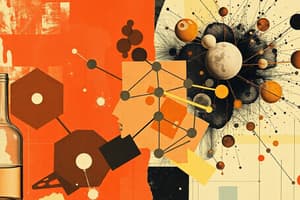Podcast
Questions and Answers
Which of the following is an example of a chemical change?
Which of the following is an example of a chemical change?
- Tearing a piece of paper
- Dissolving sugar in water
- Melting ice
- Burning a candle (correct)
What is the key difference between physical and chemical changes?
What is the key difference between physical and chemical changes?
- Physical changes occur without altering the identity of a substance, while chemical changes do alter the identity of a substance. (correct)
- Physical changes involve the formation of new compounds, while chemical changes do not.
- Physical changes involve the rearrangement of atoms, while chemical changes involve the rearrangement of molecules.
- Physical changes are reversible, while chemical changes are not.
Which of the following is an example of a physical change?
Which of the following is an example of a physical change?
- Decomposition of hydrogen peroxide
- Rusting of iron
- Crystallization of salt from a solution (correct)
- Burning of a piece of paper
What is the main difference between the processes of rusting and crystallization?
What is the main difference between the processes of rusting and crystallization?
Which of the following statements about the differences between physical and chemical changes is true?
Which of the following statements about the differences between physical and chemical changes is true?
Which of the following statements accurately distinguishes between physical and chemical changes?
Which of the following statements accurately distinguishes between physical and chemical changes?
Which of the following is an example of a chemical change?
Which of the following is an example of a chemical change?
What type of change is crystallization?
What type of change is crystallization?
Which of the following statements about physical changes is correct?
Which of the following statements about physical changes is correct?
In the rusting process, what is the role of water?
In the rusting process, what is the role of water?
Flashcards are hidden until you start studying
Study Notes
Changes in Matter: Physical vs. Chemical Changes
Introduction
Understanding the distinctions between physical and chemical changes is crucial in the field of chemistry. While both types of changes involve alterations in matter, they possess distinct characteristics and implications for the substances involved. This article will delve into the types of physical and chemical changes, their differences, and provide examples such as rusting and crystallization.
Types of Chemical Changes
Chemical changes involve alterations to the molecular structure of substances, resulting in new compounds with different properties. These changes often produce a new substance that cannot be reversed. Examples include burning a candle, which produces carbon dioxide and water from the wax, or the decomposition of hydrogen peroxide into oxygen and water.
Types of Physical Changes
Physical changes occur without altering the identity of a substance. They do not involve the formation of new compounds but rather changes in the appearance, state, or arrangement of matter. Common examples include changing the shape of an object, breaking a mirror, or melting a piece of paper.
Differences between Physical and Chemical Changes
The key difference between physical and chemical changes lies in the nature of the transformation itself. Physical changes only modify the physical properties or appearance of a substance, while chemical changes involve the formation or breaking of chemical bonds, leading to new compounds with different properties. Physical changes can often be reversed, while chemical changes generally result in irreversible alterations.
Rusting (Oxidation)
Rusting, also known as oxidation, is an example of a chemical change involving iron and oxygen, resulting in the formation of iron(III) oxide (Fe2O3). This process occurs when iron reacts with oxygen in the presence of water, causing the metal's color to change from red or brown to rust-like flakes.
Crystallization
Crystallization represents another type of physical change where a solid substance undergoes a transformation into a more ordered state. It involves the arrangement of particles into a regular structure that can be seen under a microscope. An example of this would be dissolving table salt (NaCl) in hot water and then allowing it to cool. As the solution cools, the table salt crystals gradually form a distinct shape, signifying the completion of the crystallization process.
Studying That Suits You
Use AI to generate personalized quizzes and flashcards to suit your learning preferences.




